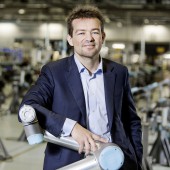UR3 UR5 UR10 Collaborative Robots by Esben Østergaard |
Home > Winners > #51872 |
 |
|
||||
| DESIGN DETAILS | |||||
| DESIGN NAME: UR3 UR5 UR10 PRIMARY FUNCTION: Collaborative Robots INSPIRATION: Universal Robots was created with the idea of a light robot that is easy to install and program while analyzing the special requirements for robots in the all industries. They could see that heavy, expensive and unwieldy robots dominated robotics and that there was a market for a more user-friendly option that can contribute with 5 benefits to the users: Easy Programing, Flexible Deployment, Fast Set-Up, Collaborative and Safe, Fast payback. UNIQUE PROPERTIES / PROJECT DESCRIPTION: Universal Robots is not just a name. When we say universal we mean it. The UR arms can be implemented in virtually any industry, in any process and by any employee. Around the world, more than 10,000 operating UR robots are testimony to just that and to the clear objective we have had from the very beginning, to make collaborative robot technology accessible to companies of all sizes. With our TUV certified robots by your side, you are in the safest of hands. OPERATION / FLOW / INTERACTION: Universal Robots lightweight robot arms come with a control box and teach pendant. After unpacking, you mount the robot on a flat surface, it can be on a desk, wall or ceiling, using four screws. Plug in the power outlet and you are ready to operate the robot. You record a number of positions by using the intuitive hand guiding and save them as robot programs. The robot arms can be used in all types of different applications. PROJECT DURATION AND LOCATION: 2004 The idea of the flexible robots started 2005 Company founded as Universal Robots 2007 First prototype UR5 2008 First sales 2009 Distribution in DK 2010 European distribution 2011 Distribution in Asia 2012 Entered US and Launch of UR10 2013 Subsidiaries in New York and Shanghai 2014 Office in Spain 2015 Launch of UR 3 and office in Singapore, India, Eastern Europe and California Universal Robots is acquired by Teradyne for 285M 2016 UR is now represented in 12 countries worldwide FITS BEST INTO CATEGORY: Product Engineering and Technical Design |
PRODUCTION / REALIZATION TECHNOLOGY: The Methodology was due to prototypes, there were a considerable number of prototypes to be used for demonstrations, the first demo was a three axis robots and the final prototype was a six-axis robot. The name of the project Flexible Robots changed to Universal Robots, Universal Robots first product was the UR5, a six jointed articulated arm robot that revolutionized the market for industrial robots. SPECIFICATIONS / TECHNICAL PROPERTIES: Performance Repeatability: 0.1 mm 0.0039 Temperature range: 0-50 degrees The robot can work in a temperature range of 0-50 degrees C. At high continuous joint speed, ambient temperature is reduced. Power consumption: Min 90W, Typical 125W, Max 250W Collaboration operation: 15 advanced adjustable safety functions. TUV NORD Approved Safety Function, Tested in accordance with: EN ISO 13849:2008 PL d, EN ISO 10218-1:2011, Clause 5.4.3, ISO Clean Classroom 5. IP Classification UR3 IP64 UR5 & UR10 IP54 Control box IP20 Tech Pendant IP20 TAGS: Universal Robots, Robotic Arm, Collaborative Robots, Industrial Robotics, Robotics RESEARCH ABSTRACT: The research type was Flexible robots, where in the analytical phase of the project the conclusion was that, from a technical point of view, robots could easily be used in monotonous and repetitive task such as placing and putting due to this conclusion the project Flexible Robots started, Robot programing is about defining points and curves in the intended work area, since new graphical interfaces had been developed for professional 3D drawing it would be possible to make a more graphical programming language for robots. CHALLENGE: During the developing years, the prototype suffered a falling accident which make them realize that the project was being underestimated and that instead of making the components by two of the participants of the project, it required a high level of quality. ADDED DATE: 2016-11-28 07:31:06 TEAM MEMBERS (1) : Esben Østergard IMAGE CREDITS: Esben Østergaard, 2016. PATENTS/COPYRIGHTS: EP1996376B1 |
||||
| Visit the following page to learn more: http://bit.ly/2gaPiGO | |||||
| AWARD DETAILS | |
 |
Ur3 Ur5 Ur10 Collaborative Robots by Esben Østergaard is Winner in Product Engineering and Technical Design Category, 2016 - 2017.· Read the interview with designer Esben Østergaard for design UR3 UR5 UR10 here.· Press Members: Login or Register to request an exclusive interview with Esben Østergaard. · Click here to register inorder to view the profile and other works by Esben Østergaard. |
| SOCIAL |
| + Add to Likes / Favorites | Send to My Email | Comment | Testimonials | View Press-Release | Press Kit |
Did you like Esben Østergaard's Engineering Design?
You will most likely enjoy other award winning engineering design as well.
Click here to view more Award Winning Engineering Design.








